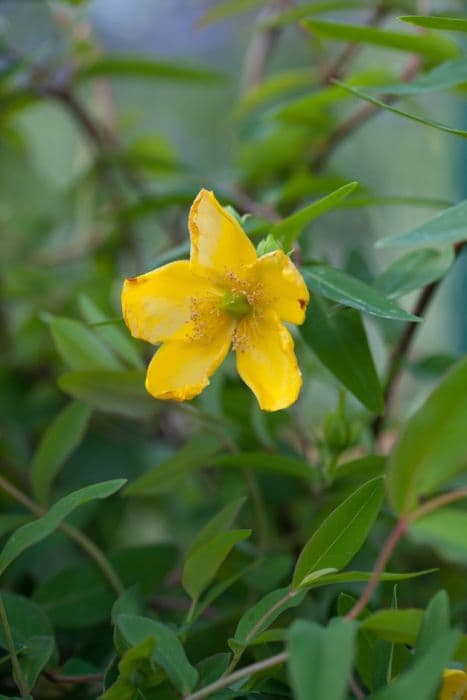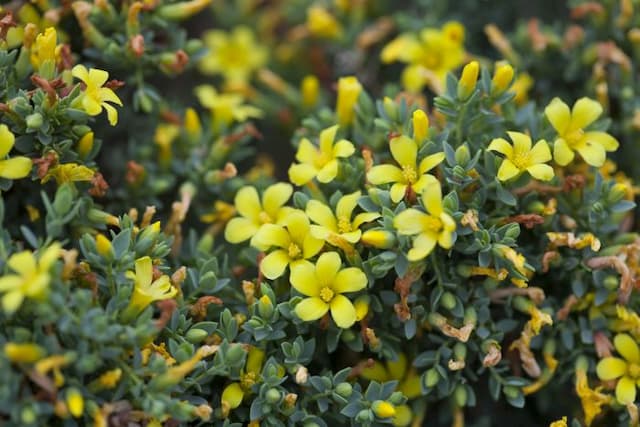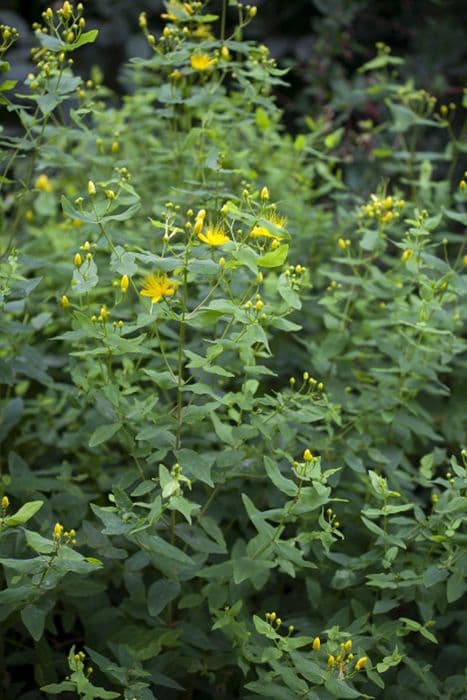Tutsan Hypericum androsaemum

ABOUT
The plant commonly known as Tutsan is an attractive shrub featuring oval-shaped leaves that are rich green in color and have a slightly glossy appearance, which adds to their aesthetic appeal. The leaves are arranged in opposite pairs along the stems, creating a lush, full look for the plant. Throughout the blooming season, Tutsan produces an abundance of bright yellow flowers. These flowers are small but numerous, with a classic star-like shape that comprises five distinct petals, which give the blooms a cheerful and inviting presence. After the flowering period, the plant forms berries that go through a remarkable color transformation as they mature. They initially appear as green, then turn to a vibrant red and eventually become a deep, almost black hue. This colorful fruit display adds a further point of interest to the plant's appearance. The berries contrast beautifully with the foliage, making Tutsan a visually striking addition to any garden setting. Overall, with its green glossy leaves, sunny yellow flowers, and colorful berries, Tutsan is a plant that can offer visual interest across multiple seasons.
About this plant
 Names
NamesFamily
Hypericaceae
Synonyms
Tutsan, Sweet Amber, Androsaemum, Shrubby St. John's Wort
Common names
Androsaemum androsaemum, Androsaemum officinale, Hypericum anglicum, Hypericum hircinum, Hypericum linarifolium, Hypericum pubescens, Hypericum tetrapterum
 Toxicity
ToxicityTo humans
Tutsan, the common name for Hypericum androsaemum, contains toxic compounds which can cause adverse effects when ingested. In humans, consuming parts of this plant may lead to symptoms including gastrointestinal irritation, such as nausea, vomiting, and diarrhea. Serious poisoning is rare, but the presence of hypericin can potentially lead to photosensitivity, causing skin inflammation when exposed to sunlight after ingestion.
To pets
In pets, Tutsan or Hypericum androsaemum is considered toxic. If ingested, the toxic components of the plant can cause symptoms similar to those in humans, such as vomiting, diarrhea, and lethargy in animals. Pets may also experience photosensitivity, leading to skin irritation or inflammation when exposed to sunlight. It is important to seek veterinary care if you suspect your pet has ingested this plant.
 Characteristics
CharacteristicsLife cycle
Perennials
Foliage type
Deciduous
Color of leaves
Green
Flower color
Yellow
Height
1-4 feet (0.3-1.2 meters)
Spread
1-2 feet (0.3-0.6 meters)
Plant type
Shrub
Hardiness zones
5-9
Native area
Europe
Benefits
 General Benefits
General Benefits- Ornamental Value: Hypericum androsaemum, commonly known as Tutsan, is widely used in gardens and landscapes for its attractive yellow flowers and reddish-purple fruits.
- Wildlife Habitat: It provides food and habitat for various species of birds and insects, which are drawn to its berries and nectar-rich flowers.
- Erosion Control: The plant's dense growth habit can help stabilize soil and prevent erosion on slopes or in areas with loose soil.
- Low Maintenance: Tutsan is known for being a low-maintenance plant that requires minimal care once established, making it suitable for novice gardeners.
- Drought Tolerance: Once established, it can tolerate periods of drought, making it suitable for xeriscaping or regions with water scarcity.
- Pollinator Attraction: The flowers of the Tutsan attract bees and other pollinating insects, contributing to the health of the local ecosystem.
- Cultural Significance: Tutsan has been used in traditional celebrations and folklore in various cultures, adding cultural value to its presence in gardens.
 Medical Properties
Medical Properties- Antidepressant: Hypericum androsaemum, also known as Tutsan, has been used traditionally for its potential antidepressant properties, similarly to its relative Hypericum perforatum (St. John's Wort).
- Anti-inflammatory: Compounds within Tutsan may have anti-inflammatory effects, which could be beneficial in treating inflammation-related conditions.
- Antimicrobial: Extracts from Tutsan have shown antimicrobial activity in scientific studies, suggesting a potential use in fighting infections.
- Antiviral: Some research indicates that Hypericum species may possess antiviral properties, which could be applicable to Tutsan.
- Antioxidant: Tutsan contains antioxidants, which can help in neutralizing harmful free radicals in the body.
- Wound healing: Traditionally, Tutsan has been applied to wounds to promote healing, possibly due to its antimicrobial and anti-inflammatory properties.
 Air-purifying Qualities
Air-purifying QualitiesThis plant is not specifically known for air purifying qualities.
 Other Uses
Other Uses- As a dye: The vivid red color of the ripe fruits of Tutsan can be used to make natural dyes for textiles and other materials.
- In landscape design: Tutsan is often used as an ornamental shrub in gardens due to its attractive yellow flowers and red-to-black berries.
- Flower arrangements: The flowers and berries of Tutsan can add a splash of color to cut flower bouquets.
- Craft projects: The colorful berries can be used for craft projects, such as making wreaths or other decorations.
- Insect repellent: The aromatic properties of Tutsan may help to deter certain insects when planted in the garden.
- Photography: Tutsan's vibrant flowers and berries make it an excellent subject for botanical photography.
- Erosion control: Tutsan can be used for soil stabilization on slopes due to its dense growth habit.
- Wildlife habitat: The shrub provides shelter and food for birds and other wildlife.
- Environmental education: Tutsan can be used in educational settings to teach about plant life cycles and native species.
- Cultural significance: In some cultures, Tutsan is associated with folklore and may be incorporated into traditional ceremonies.
Interesting Facts
 Feng Shui
Feng ShuiTutsan is not used in Feng Shui practice.
 Zodiac Sign Compitability
Zodiac Sign CompitabilityTutsan is not used in astrology practice.
 Plant Symbolism
Plant Symbolism- Protection: Hypericum androsaemum, commonly known as Tutsan, has been traditionally believed to ward off evil spirits and negative energies. It was often used in rituals to protect against supernatural forces.
- Healing: Due to its medicinal properties, Tutsan is symbolic of healing both physical and emotional wounds. It has been used in herbal medicine to treat various ailments.
- Optimism and Good Luck: The bright yellow flowers of the Tutsan plant are symbolic of happiness and optimism. They are often associated with bringing good luck and positive outcomes.
- Strength: Tutsan's ability to grow in various conditions symbolizes strength and resilience. It is often seen as a metaphor for overcoming adversity.
 Water
WaterTutsan should be watered when the top inch of soil feels dry to the touch. Thoroughly soak the soil until water runs out of the bottom of the pot, but do not leave the plant standing in water as this can lead to root rot. Generally, this may equate to watering approximately once a week, but this frequency can vary depending on environmental conditions such as temperature and humidity. In terms of amount, it's best to provide about half a gallon for larger pots or 8-16 ounces for smaller containers every watering session, adjusting as necessary based on the plant's response and the season.
 Light
LightTutsan flourishes in full sun to partial shade. The best lighting condition for this plant is a spot where it can receive bright, indirect sunlight for at least part of the day. Too much direct sunlight might cause leaf scorch, whereas too little will result in fewer blooms. A north- or east-facing window or a position in the garden that gets some afternoon shade would be ideal for Tutsan.
 Temperature
TemperatureTutsan thrives in moderate temperatures, doing well in a range between 50 to 75 degrees Fahrenheit. It can survive minimum temperatures down to 10 degrees Fahrenheit, making it suitable for outdoor gardening in many climates. However, it's important to protect the plant from frost and ensure that the temperature does not exceed 90 degrees Fahrenheit for prolonged periods, as this can stress the plant.
 Pruning
PruningTutsan should be pruned to shape the plant, remove dead or damaged stems, and promote bushier growth. Pruning is best done in the early spring before new growth starts or immediately after the plant has finished blooming, which is often in late summer. Regularly remove spent flowers to encourage additional blooming. Pruning every year or every other year is generally sufficient to keep Tutsan healthy and well-shaped.
 Cleaning
CleaningAs needed
 Soil
SoilTutsan requires well-draining soil with a pH range of 5.5 to 7. A mix of loamy soil, peat, and sand or perlite is ideal to ensure good drainage and aeration. Adding organic compost can enrich the soil and provide essential nutrients for plant health.
 Repotting
RepottingTutsan should be repotted every 2 to 3 years or when it becomes root-bound. Choose a pot that is one size larger than the current one to allow for growth, and repot in spring before the start of the growing season.
 Humidity & Misting
Humidity & MistingTutsan thrives in moderate humidity levels, typically around 40-60%. It is adaptable to average household humidity, but if the air is too dry, occasional misting can help maintain its vigor.
 Suitable locations
Suitable locationsIndoor
Place Tutsan in bright, indirect light, and water when topsoil feels dry.
Outdoor
Plant Tutsan in partial shade; keep soil moist but well-drained.
Hardiness zone
5-9 USDA
 Life cycle
Life cycleTutsan (Hypericum androsaemum) begins its life cycle as a seed, which germinates in the spring under suitable conditions of moisture and temperature. The seedling emerges and develops into a young plant with a rosette of leaves at ground level. As the tutsan matures, it forms an upright, woody, branching stem with ovate, slightly leathery leaves. By early to mid-summer, the plant produces clusters of yellow, star-shaped flowers, each with a tuft of noticeable stamens, leading to pollination by insects. After pollination, the flowers develop into red to purplish-black berries by late summer or early fall. The plant can propagate either by seed dispersal from its berries or vegetatively through its root system, completing its life cycle and potentially creating new patches of tutsan in the vicinity.
 Propogation
PropogationPropogation time
Spring to summer
The most popular method of propagation for Hypericum androsaemum, commonly known as Tutsan, is through semi-hardwood cuttings. This process typically begins in late summer when the current year's growth has begun to mature and harden slightly. To propagate Tutsan, you take cuttings of about 4 to 6 inches (approximately 10 to 15 centimeters) in length, ensuring that each cutting has at least a couple of leaves. The cut end of the cutting is often dipped in rooting hormone to encourage root development, after which the cutting is placed in a well-draining soil mix. The environment should be kept humid, often by covering the pot with a plastic bag or placing it in a propagator, and it should be placed in indirect light until roots have developed and the plant can be potted up individually.








